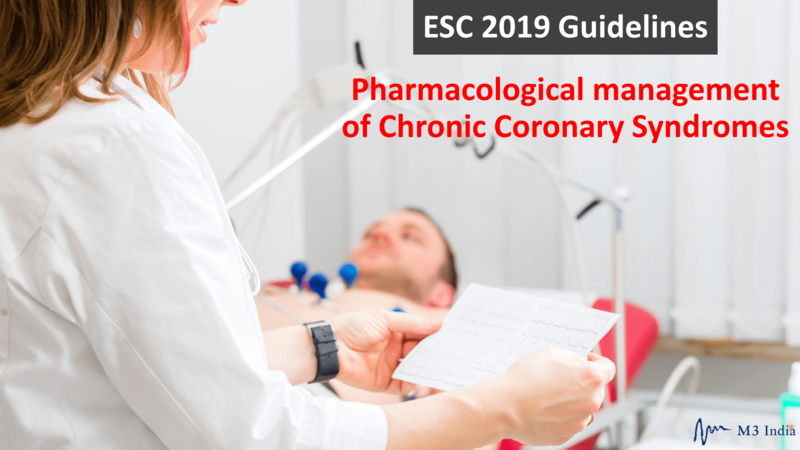Pharmacological Management of Chronic Coronary Syndromes: 2019 ESC Guidelines
M3 India Newsdesk Oct 28, 2019
The main goals of pharmacological management of chronic coronary syndromes (CCS) patients are to reduce angina symptoms and exercise-induced ischaemia, and to prevent cardiovascular events.

As per the 2019 ESC guideline, medical treatment of symptomatic patients requires one or more drugs for angina/ischaemia relief in association with drugs for event prevention. The guideline also recommends timely review of the patient’s response to medical therapies. Immediate relief of anginal symptoms, or the prevention of symptoms under circumstances likely to elicit angina, can be obtained with rapidly acting formulations of nitroglycerin. Anti-ischaemic drugs along with lifestyle changes, regular exercise training, patient education, and revascularization—all are important for long-term disease prevention.
Recommendations on anti-ischaemic drugs in patients with chronic coronary syndromes
As per the 2019 ESC guidelines, medical treatment of symptomatic patients requires one or more drugs for angina/ischaemia relief in association with drugs for event prevention. Timely review of the patient’s response to medical therapies, such as, 24 weeks after drug initiation, is also necessary and recommended by the guidelines.
Short-acting nitrates are recommended for immediate relief of effort angina.
Short-acting nitrate formulations such as sublingual and spray nitroglycerin should be used for immediate relief in effort angina. Nitroglycerin (0.3–0.6 mg tablet sublingually or 0.4 mg spray to the tongue) should be taken in a sitting position every 5 min until the pain disappears, or a maximum of 1.2 mg has been taken within 15 min. Nitroglycerin can also be used prophylactically prior to physical activities known to trigger angina.
First-line treatment is indicated with beta-blockers and/or calcium channel blockers (CCBs) to control heart rate and symptoms.
- Beta-adrenergic blockers or CCBs are recommended as the drug of choice in CCS. Beta-blockers have been associated with a significant reduction in mortality and/or cardiovascular events in patients with recent myocardial infarction (MI) and those with chronic heart failure
- (HF) with reduced ejection fraction. The dose of beta-blockers should be adjusted to limit the heart rate to 55–60 beats per minute at rest.
- CCBs improve symptoms and myocardial ischaemia; however, they are not associated with reduction in morbidity or mortality in patients with CCS
If angina symptoms are not successfully controlled on a beta-blocker or a CCB, the combination of a beta-blocker with a DHP-CCB should be considered.
Beta-blockers can be combined with dihydropyridine (DHP) CCBs to reduce DHP-induced tachycardia. Long-acting nifedipine is a powerful arterial vasodilator, which can be used in hypertensive anginal patients in combination with beta-blockade. The use of beta-blocker with verapamil or diltiazem can lead to worsening of heart failure, excessive bradycardia, and/or atrioventricular block; hence, caution is warranted.
Long-acting nitrates should be considered as a second-line treatment option when initial therapy with a beta-blocker and/or a non-DHP-CCB is contraindicated, poorly tolerated, or inadequate to control angina symptoms.
In cases where initial therapy with a beta-blocker or non-dihydropyridine (non-DHP) CCB is contraindicated, not tolerated, or inadequate to control symptoms, long-acting nitrate formulations are recommended as second-line therapy for angina relief. Long-acting nitrate formulations such as nitroglycerin, isosorbide dinitrate, and isosorbide mononitrate can be administered orally or transdermally through slow-release patch systems.
A nitrate-free or nitrate-low interval of around 10–14 h should be considered when prescribing long-acting nitrates for prolonged periods. Dose titration is necessary with all nitrate formulations. Discontinuation should also be tapered carefully to prevent rebound angina.
Nitrates are not recommended in patients with hypertrophic obstructive cardiomyopathy or co-administration of phosphodiesterase inhibitors.
Nicorandil, ranolazine, ivabradine, or trimetazidine should be considered as a second-line treatment to reduce angina frequency and improve exercise tolerance in subjects who cannot tolerate, have contraindications to, or whose symptoms are not adequately controlled by beta-blockers, CCBs, and long-acting nitrates.
Ivabradine is comparable to atenolol or amlodipine in the treatment of angina and ischaemia in patients with CCS. Adding ivabradine to atenolol therapy can help control heart rate and anginal symptoms. Nicorandil has antianginal effects similar to nitrates or beta-blockers. Ranolazine and trimetazidine can also be used as a second-line drug in CCS patients with refractory angina despite the use of beta-blockers, CCBs, and/or long-acting nitrates.
In subjects with baseline low heart rate and low blood pressure (BP), ranolazine or trimetazidine may be considered as a first-line drug to reduce angina frequency and improve exercise tolerance.
In patients with low BP, a low-dose beta-blocker or low-dose non-DHP-CCB can be tested first under close monitoring of tolerance. Ivabradine (in patients with sinus rhythm), ranolazine, or trimetazidine can also be considered.
In patients with with baseline bradycardia (e.g. heart rate <60 b.p.m.) heart rate-lowering drugs (beta-blockers, ivabradine, and heart-rate lowering CCBs) should be avoided or used carefully, and—if needed—initiated at very low doses. Antianginal drugs without heart rate-lowering effects should preferably be given.
-
Exclusive Write-ups & Webinars by KOLs
-
Daily Quiz by specialty
-
Paid Market Research Surveys
-
Case discussions, News & Journals' summaries